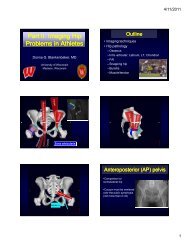Ankle and Foot 47 - Department of Radiology - University of ...
Ankle and Foot 47 - Department of Radiology - University of ...
Ankle and Foot 47 - Department of Radiology - University of ...
Create successful ePaper yourself
Turn your PDF publications into a flip-book with our unique Google optimized e-Paper software.
<strong>47</strong> <strong>Ankle</strong> <strong>and</strong> <strong>Foot</strong> 2297 <strong>47</strong><br />
Figure <strong>47</strong>-102. Navicular fatigue (stress) fracture<br />
in a 16-year-old who developed midfoot pain while<br />
cross-country skiing. A, Anteroposterior radiograph <strong>of</strong><br />
the foot reveals a subtle nondisplaced fracture in the<br />
middle third <strong>of</strong> the navicular (arrowhead in magnified<br />
dashed box). MRI was obtained 4 days later. Axial<br />
oblique T1- (B) <strong>and</strong> fat-suppressed T2-weighted (C)<br />
images reveal a discrete fracture in the middle third <strong>of</strong><br />
the navicular (arrowhead) as well as diffuse bone<br />
marrow edema.<br />
Continued<br />
A<br />
B<br />
C<br />
developed a specific CT protocol that reformats the images<br />
in thin, 1-mm slices using a small, 6-cm FOV centered on<br />
the navicular (see Fig. <strong>47</strong>-<strong>47</strong>D).<br />
Whether seen by CT or MRI, navicular fatigue injuries<br />
begin at the dorsal, central, proximal navicular where it<br />
articulates with the head <strong>of</strong> the talus. This is illustrated by<br />
the black arrows pointing to the dark regions <strong>of</strong> bone<br />
marrow on the T1-weighted images in the stress reaction<br />
in Figure <strong>47</strong>-101. More fluid-sensitive fat-suppressed T2-<br />
weighted or inversion recovery images show bone marrow<br />
edema emanating from this dorsal/central/proximal site.<br />
This is illustrated by the white arrows in Figure <strong>47</strong>-101.<br />
When stress reactions progress to stress fractures, the cortical<br />
disruption starts at the dorsal/central/proximal site<br />
on the navicular <strong>and</strong> propagates in a plantar direction<br />
vertically in the sagittal plane (see Fig. <strong>47</strong>-102) or in an<br />
oblique sagittal plane (see Fig. <strong>47</strong>-103). Because <strong>of</strong> the<br />
primarily sagittal orientation <strong>of</strong> these fractures, they may<br />
be difficult to appreciate on sagittal CT images <strong>and</strong> are<br />
better seen on oblique coronal (see Fig. <strong>47</strong>-102F) <strong>and</strong><br />
oblique axial (see Fig. <strong>47</strong>-102G) images. Because they tend<br />
to be nondisplaced incomplete fractures, they are best seen<br />
on images that are reformatted into a small FOV with thin<br />
slices. Because these patients may undergo serial CT scans<br />
to follow the progress <strong>of</strong> fracture healing, it is useful to<br />
have a st<strong>and</strong>ard protocol (as in Fig. <strong>47</strong>-<strong>47</strong>D) to help retain<br />
uniform reformatting parameters from one scan to the next<br />
(see Fig. <strong>47</strong>-103C to F).<br />
Ch0<strong>47</strong>-A05375.indd 2297<br />
9/9/2008 5:35:56 PM
















